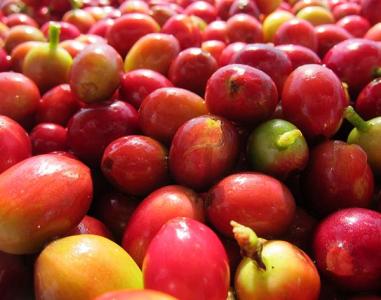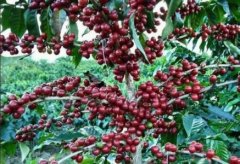Brief introduction of Qianjie boutique coffee beans Ethiopia washing Sidamo G1 honey import microbatches

In this micro-batch coffee, 100% Red Cherry was selected by hand, then the peel and pulp was removed by Agared equipment, and then the coffee beans with pectin were fermented in a fermentation tank for 36 hours, then Souking for 4 hours, dried in a drying bed with a size of 30 to 1.8 meters, and then shelled. After manual screening, they were packed in GrainPro bags and covered with gunny bags.
Producing area: Oromia, Ethiopia
Varieties: Ethiopian native species
Haiba: 2000
Treatment: washing
Flavor description:
Obvious wild ginger and bergamot, with notes of blackcurrant, sweet aftertaste of raisins, and overall flavor reminiscent of Earl black tea
Name: coffee factory address: Guangzhou Yuexiu Guan District Baoqian Street 10 Qianjie coffee manufacturers contact information: 38364473 shelf life: 90 net content: 227g packaging: bulk coffee beans ripe degree: whether coffee beans contain sugar: sugar-free origin: Ethiopia roasting degree: light roasting
Various forms of coffee cultivation can be found in Ethiopia: everything from wild coffee forests and semi-developed land to traditionally operated plots to modern plantations. About 50% of the coffee is grown more than 1500 meters above sea level. According to the above four different modes of production, Ethiopian coffee can be divided into nine major coffee producing areas, including five boutique coffee areas: Sidamo, Yegashefi, Harald, Lim and Lekampu. and four general commercial bean producing areas: Gemma, Irugbo, Tibby and Bekaa. The sun or water washing methods are used in each district, and different treatment methods also affect the flavor. At present, the sun method accounts for about 80%, and water washing accounts for about 20%.
The Oromia region is one of the sources of coffee in the world, and its native Oromo is the first person in the world to use coffee as a food, dating back to the 5th century AD. Oromia is located at about 3-15 degrees north latitude and 33-40 degrees longitude. The region is famous for its primordial plant species and species diversity. This is where coffee was born. For the local Oromo people, coffee is their drink, their food, an important part of their trade, a local "stimulant" and an important tool for safeguarding peace.
Important Notice :
前街咖啡 FrontStreet Coffee has moved to new addredd:
FrontStreet Coffee Address: 315,Donghua East Road,GuangZhou
Tel:020 38364473
- Prev

A Brief Introduction to the Processing Method of Grinding Degree and Roasting Degree of Lares Yaoko Fine Coffee Beans with Full Flavor
Puerto Rico's coffee beans are carefully grown, pure, aromatic and granular. The best coffee is Yauco Selecto, which means select. Grown only on three farms in the south-west of the island, San Pedro, Caracolillo and La Juanita, Yocote Coffee has a strong aroma and a long aftertaste, making it a true premium coffee. Puerto Rico
- Next

Costa Rican black honey treats Kadu Etala producing area Faramy Manor boutique single coffee bean Jane
We usually see the honey treatment methods are: yellow honey, red honey, black honey yellow honey: about 40% of the pectin is removed; the drying method requires the most direct heat absorption, receives the most light drying, and lasts for about 8 days to reach a stable water content. Red honey: about 25% of the pectin is removed; it takes longer to dry than yellow honey, and reduces the time spent in direct sunlight, even using
Related
- Detailed explanation of Jadeite planting Land in Panamanian Jadeite Manor introduction to the grading system of Jadeite competitive bidding, Red bid, Green bid and Rose Summer
- Story of Coffee planting in Brenka region of Costa Rica Stonehenge Manor anaerobic heavy honey treatment of flavor mouth
- What's on the barrel of Blue Mountain Coffee beans?
- Can American coffee also pull flowers? How to use hot American style to pull out a good-looking pattern?
- Can you make a cold extract with coffee beans? What is the right proportion for cold-extracted coffee formula?
- Indonesian PWN Gold Mandrine Coffee Origin Features Flavor How to Chong? Mandolin coffee is American.
- A brief introduction to the flavor characteristics of Brazilian yellow bourbon coffee beans
- What is the effect of different water quality on the flavor of cold-extracted coffee? What kind of water is best for brewing coffee?
- Why do you think of Rose Summer whenever you mention Panamanian coffee?
- Introduction to the characteristics of authentic blue mountain coffee bean producing areas? What is the CIB Coffee Authority in Jamaica?

